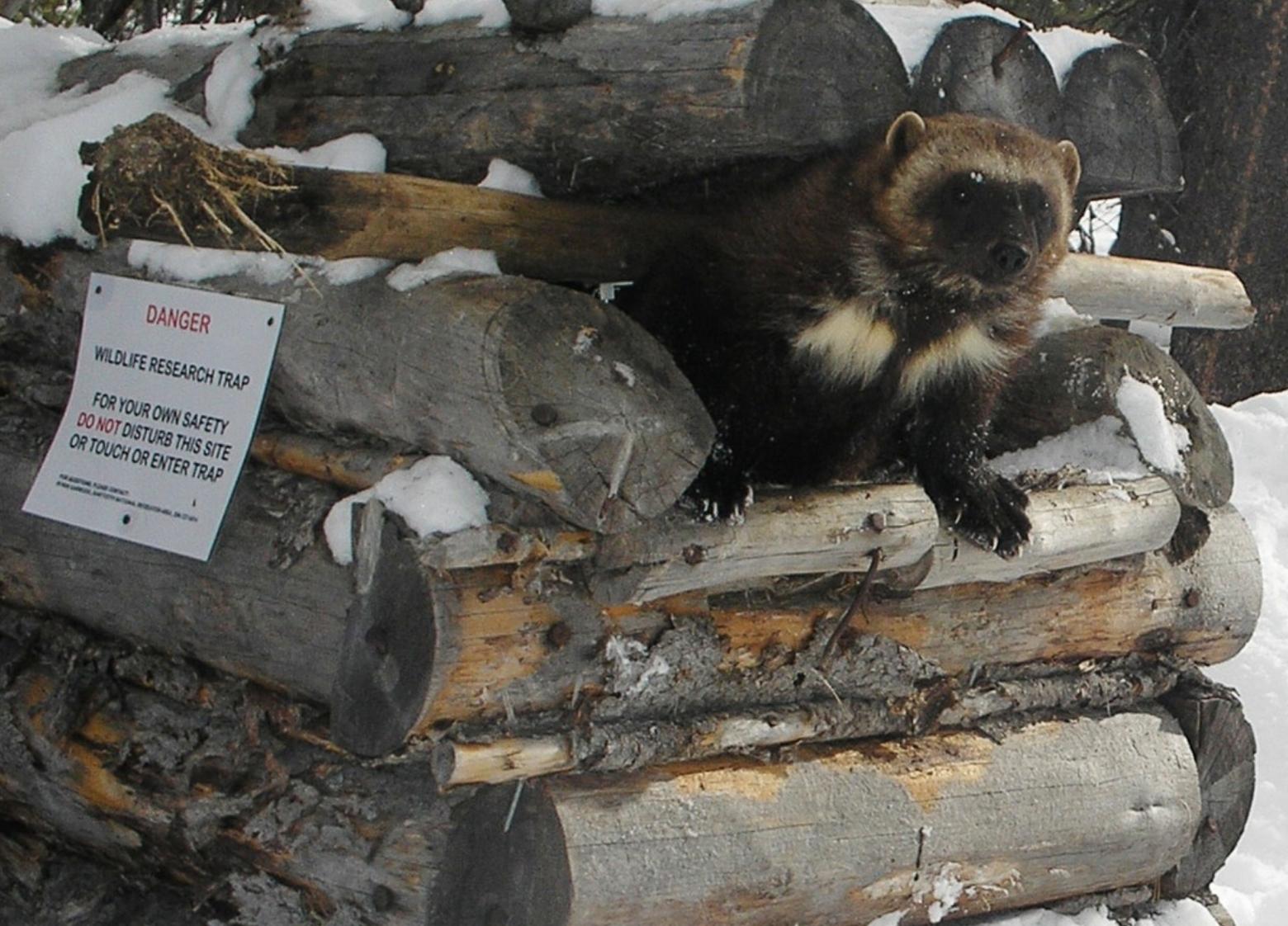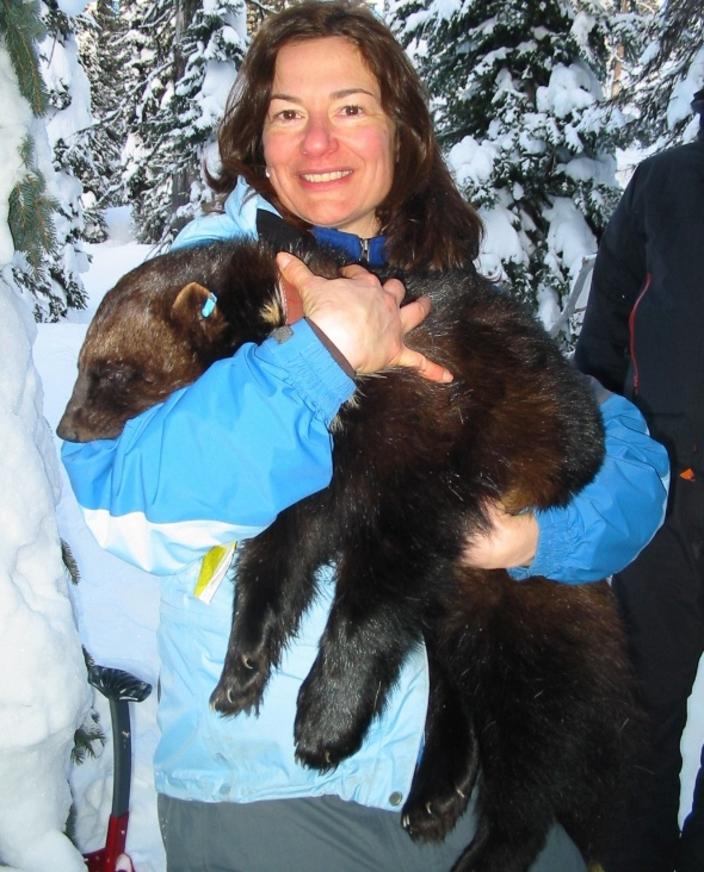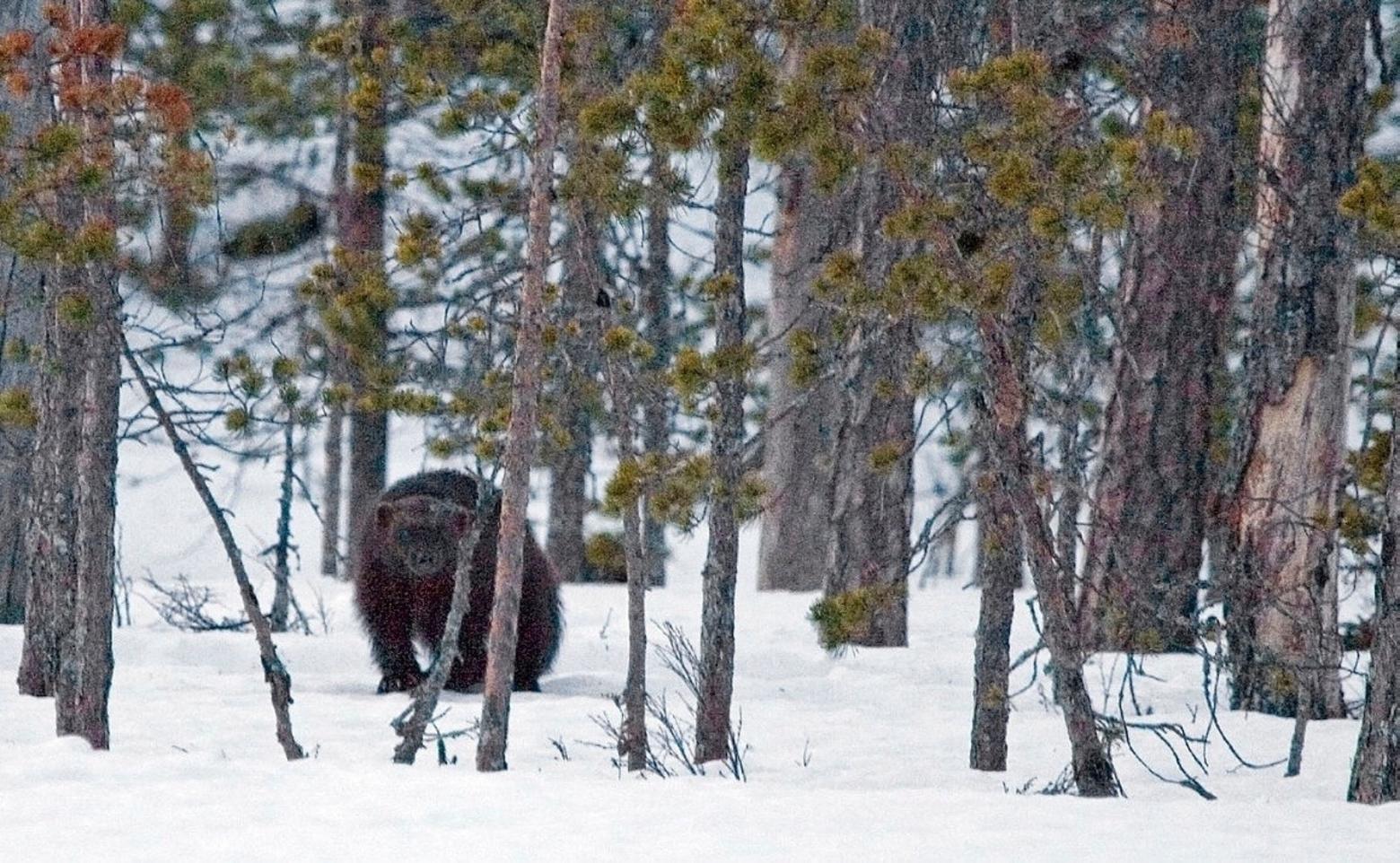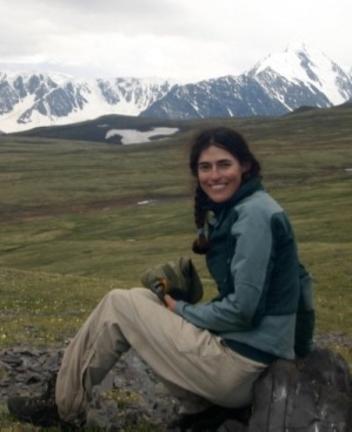Back to StoriesA Wolverine Named Olive
June 12, 2020
A Wolverine Named OliveWhat her story and that of others tells us about the impacts of recreation on sensitive species
What are the potential impacts of outdoor recreation on uncommon,
discreet, solitude-seeking species like the wolverine? Recent media reports have been circulated
about the conclusions of a study that sought out, in part, to answer the
question.
This is, in a way, an adventure story related to the
research and a female wolverine nicknamed “Olive”.
In early spring of 2013, this juvenile wolverine from the Boulder
Mountains in Idaho abruptly disappeared. The Wolverine Winter Recreation
Project had collared and bestowed her with a
moniker. They had been monitoring her for several weeks when she vanished.
When flights and cameras failed to pick her up anywhere in
the Boulder or surrounding White Clouds, Sawtooths, or Smoky mountains, the
project’s lead scientist, Dr. Kim Heinemeyer, accepted that she might never
find out what had happened to Olive.
Then, suddenly, a collared wolverine started showing up in
camera trap photos at the project’s site near McCall, Idaho. Heinemeyer quickly
got a crew to dig closed research traps out from beneath the spring snowpack,
open, bait them, and capture the collared wolverine.
Sure enough, it was
Olive. She was more than 60 miles from her last known location. The data from
her collar showed that while the project had been searching for her on the
Sawtooth National Forest, she’d made her way north and occupied the abandoned
territory of another of the study’s female wolverines, Lily. Lily had disappeared
sometime between spring of 2012 and Olive’s arrival, and Olive had moved in and
established the same exact boundaries that Lily had maintained.
Documenting the successful dispersal of a juvenile wolverine,
and the transition of a territory from an adult female to a successor would
have been accomplishment enough, but Olive went on to produce kits a year
later, another major milestone in the life of a wolverine.
For the project, which was looking at the relationship
between winter recreation and the wolverine population, it would offer data
about how female wolverines responded to recreation during the crucial denning
season, which lasts from February to May. The area around McCall was heavily
recreated by snowmobilers and skiers, so having a denning female in the area
was an unexpected coup for the research.
Then Olive vanished again.
She stopped showing up at camera stations and traps. Her
collar’s batteries ran out and the collar shut off. Had she died? Lost her kits
and left?
For a year, the project had no idea what happened to her.
The next winter, she appeared on camera again. Her collar was hanging by a
thread; the rot-away stitching that was supposed to allow her to shed the
collar hadn’t worn through. Heinemeyer once again called an emergency trapping
effort to retrieve the collar, but Olive eluded capture and the collar fell off
somewhere in the wilds of the Payette National Forest. It was never found, so the
data were never retrieved and the mystery of Olive’s second vanishing act was
never solved.
The gaps in Olive’s data illustrate why it can be so hard to
reach conclusions about the management needs of a rare, wide-ranging animal
like the wolverine. We cannot say that she left because of recreation, but we
can’t say that she didn’t, either.
The Wolverine Winter
Recreation Project, which ran from 2009 to 2015 and encompassed wolverine
habitat from the Payette National Forest to the Tetons in Greater Yellowstone,
was one of the largest wolverine collar studies ever conducted in terms of the
logistics, the number of animals collared, and the datasets generated.
It produced probably the single largest dataset on motorized
and non-motorized winter backcountry recreation in the U.S., with skiers and
snowmobilers carrying GPS trackers to document 5899 adventures. Twenty-four
wolverines also carried GPS collars, generating fixes every 20 minutes on
weekends, when recreation activity was predicted to be high, and again at
midweek, when recreation activity was predicted to be low.
This extraordinary effort offers a complex picture of
wolverine response to winter recreation. The results don’t provide a simple
answer to the question of whether recreation harms wolverines, but rather
illustrate where and how wolverines will feel the effects of recreation.
Heinemeyer says the study shows three key things:
One, that resident wolverines establish and maintain
territories and reproduce in recreated habitat, including in heavily recreated
regions like the Payette Forest.
Two, that at the home range scale, wolverines avoid both
motorized and non-motorized recreation.
Three, that wolverines avoid recreation along roads, and
also dispersed recreation, but that they most strongly avoid dispersed
backcountry recreation – motorized and non-motorized alike.
This suggests that wolverines are not so incredibly
sensitive that a single, isolated encounter with a skier or snowmobile will
traumatize them, yet it also suggests that recreation at a certain intensity
will exclude a wolverine from portions of its own territory – potentially substantial
portions.
The study’s female wolverines avoided between 2 percent and 28.4 percent of
their own territories due to recreation; the percentages could trend much
higher looking at only the highest quality habitat within a territory (Olive
avoided 24.5 percent of her entire territory, but 72 percent of the highest-quality habitat
within her territory). Effectively, recreation in a wolverine’s territory
reduces the quality of the habitat within that territory.
The results also show that a wolverine will more strongly
avoid recreation the more it is exposed. In a response that is the opposite of
habituation, wolverines appear to become more wary of recreation the more they
see of it. Higher levels of recreation therefore create a greater negative
impact. Most recreated areas in the western US are used repeatedly by multiple
people, which means that for a resident adult wolverine, there is no such thing
as a single, isolated encounter with a skier or a snowmobiler. The study showed that wolverines’ tolerance of some levels of recreation may create a problematic
sense of complacency because it fails to account for how wolverines are likely
to respond to increasing exposure to recreation over time and across space.
Almost all backcountry recreation in Montana, Idaho, and
Wyoming occurs in wolverine habitat, and with the human population in the
region growing, and snowpack declining in the face of global warming, more and
more recreationists will likely be using the places wolverines depend on.
A recent Canadian study suggests that wolverines also avoid roads, and in the meta-population structure
that we find among wolverines in the Rockies, development in valley bottoms
that aren’t wolverine habitat could still impede connectivity among population
nodes in different mountain ranges.
A wolverine like
Olive could face obstacles dispersing, and might also feel the impacts of
increased recreation use once she establishes a territory. So even outside of
the key issue of climate change, the looming impacts of human population growth
are a real consideration for wolverines.
It would be easy to panic at this point, and start pointing
to an inevitable conflict in the making between recreationists and wildlife
advocates. Misreading the science and wedging wolverines into preexisting
agendas against recreation is not helpful. But neither is misreading the
science in the other direction, to suggest that there’s nothing to worry about
and that some tolerance of recreation indicates tolerance of all recreation at
all levels.
"It would be easy to panic at this point, and start pointing to an inevitable conflict in the making between recreationists and wildlife advocates. Misreading the science and wedging wolverines into preexisting agendas against recreation is not helpful. But neither is misreading the science in the other direction..."
Instead, the Wolverine Winter Recreation Project asks us to
consider nuance and consider hard
questions instead of reach for easy answers: what do we want for our ecosystem
in the future, how do we get there, and are we willing to place limits on
ourselves to protect our values?
For her part, Kim Heinemeyer is hopeful. A fourth lesson
that she draws from directing the Wolverine Winter Recreation Project is not
about the data, but about the process.
Back in 2008, the Idaho Snowmobile Association approached
the wolverine research community to propose a study of recreation impacts. They
wanted decision-making that was based on good science.
Although snowmobilers are not traditionally associated with
wildlife advocacy, their initiative launched the project, bringing together the
Forest Service’s Rocky Mountain Research Station, five national forests, a
national park, the non-profit research organization Round River Conservation
Studies, dozens of local businesses who agreed to serve as collection points
for recreationists’ GPS monitors and offered discounts to people in order to
incentivize participation, and thousands of skiers and snowmobilers who got to
own a data point in the study by documenting their routes.
Heinemeyer, in her public presentations, highlights the ski
tracks of one daring individual who skied Buck Peak in the Tetons – if that was
you, congratulations, you’re immortal in the annals of science.
This level of
cooperation among stakeholders is notable in a field so often riven by conflict
between different interest groups. It shows that there are common interests
among skiers, snowmobilers, and wolverines, and that we all have a stake in the
snow and the cold mountain ecosystem that supports wolverines and drives the
winter recreation economy. Heinemeyer hopes that this insight will guide the
next steps into further research and into whatever management discussions and
decisions are made.
Besides the data on wolverines, Heinemeyer says, “What we
discovered – and I don’t know why humans have to learn this again and again –
is that diverse groups come up with better solutions to our problems. What we
need is people who love the backcountry,” regardless of their background. It’s
that investment in shared values that will be the key to keeping wolverines on
the landscape in the future.






